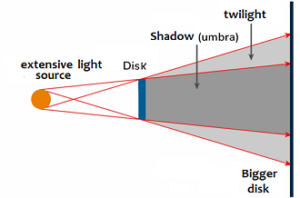
Eclipse, shadow and twilight
We have seen historical and mystical aspects of the annular Eclipse, now let us focus only on the phenomenon.
the annular Eclipse, now let us focus only on the phenomenon.
The Eclipse is a natural phenomenon that occurs when a body is within a region of shadow caused by another body that has enough light to reduce the luminosity. In the case of a solar eclipse, the Sun is the luminous star and the Moon is positioned between the Sun and Earth, producing a shadow on Earth.
For the Moon to cast a shadow on the Earth, it must be in the New Moon phase, which is when it is between the Sun and the Earth and has a slight semi-arc on one of its edges.
To better understand how eclipses occur, we need to know the concepts of shadow and twilight.
A shadow is when from a point source of light (that is, its dimensions can be neglected as if it were a single point) it is projected onto a smaller intermediate object that will produce a shadow on the larger object, this shadow can also be called an umbra.
In the penumbra there is an extensive source of light, which must be taken into account when the light source is very large or is close to the object, in the case of the Sun it is large enough to produce, from the light on the Moon, a shadow and a penumbra over the Earth (figure).
Thus, the rays of light do not come from a single point, due to the size of the Sun, but from several points, so there will be a region in which it produces a shadow, but others with partial lighting that produce some shades of twilight.
In the figure, the shield disk is the Moon and the larger disk is the Earth. For educational purposes, only one region of shadow was produced, but they are diverse and weaken as they move away from the shadow region.
The phenomenon of the lunar eclipse next Saturday (10/14) is special because an arc around the Sun becomes visible and is therefore called an Annular Eclipse (in the form of a ring).









